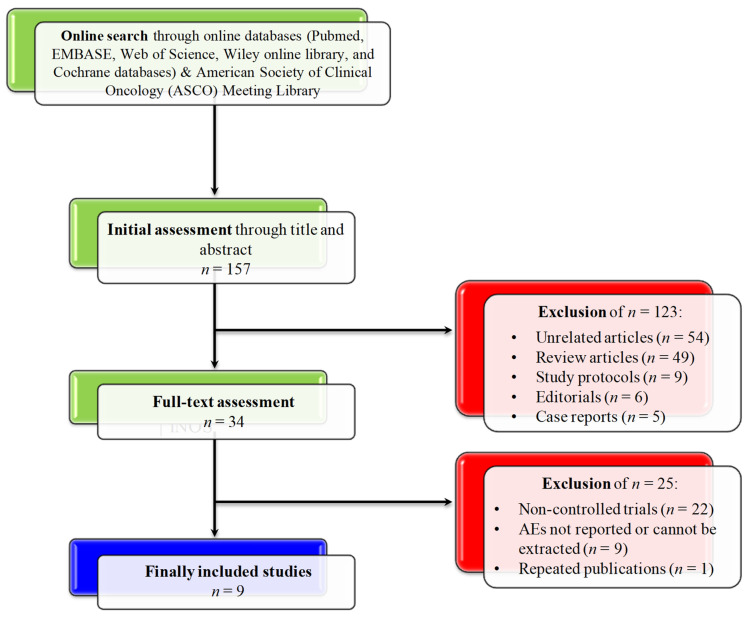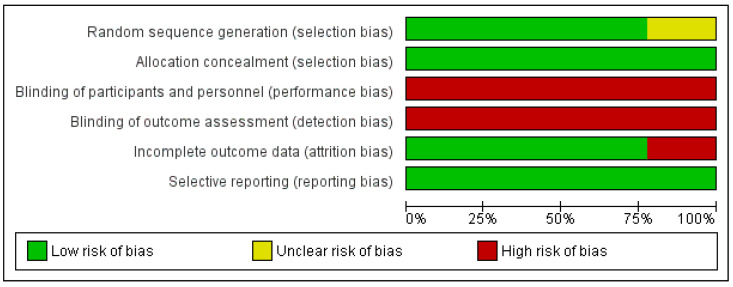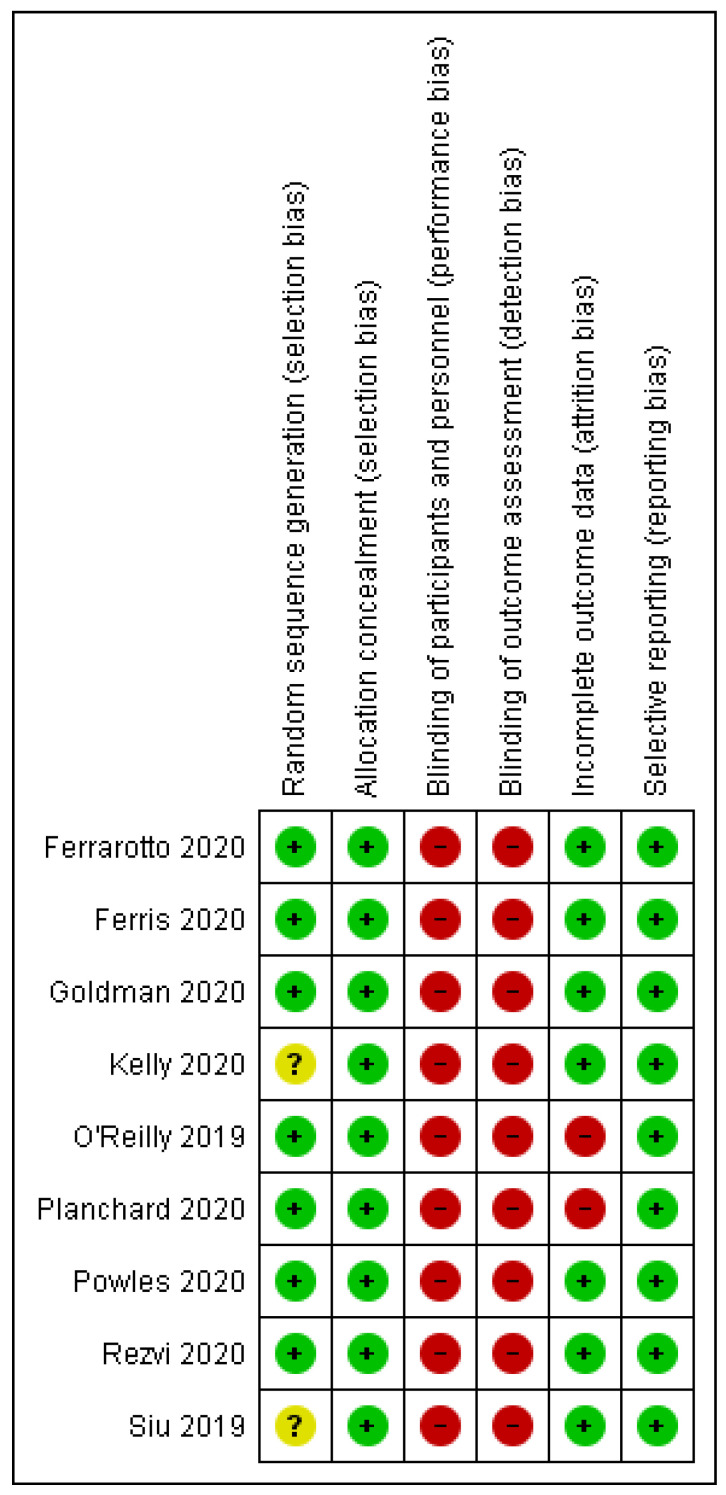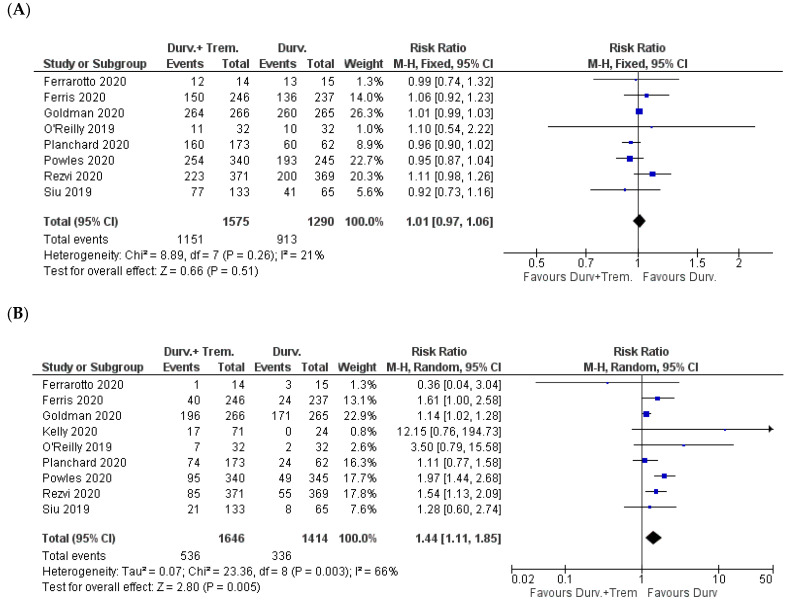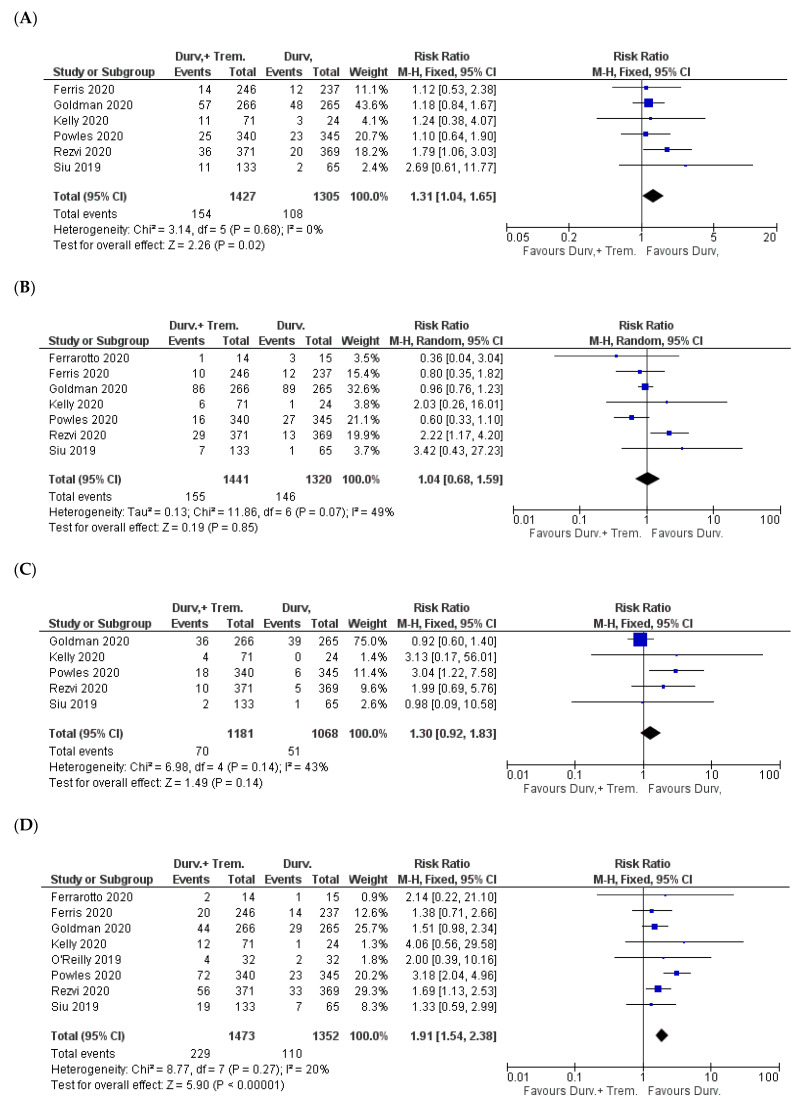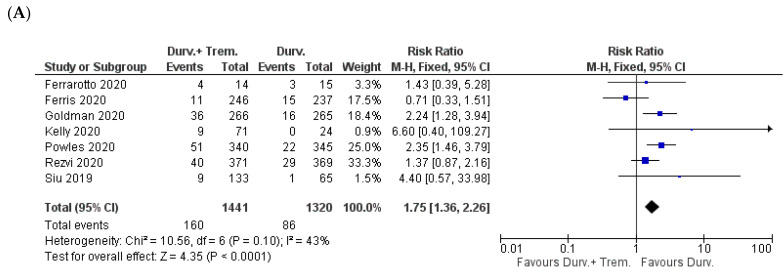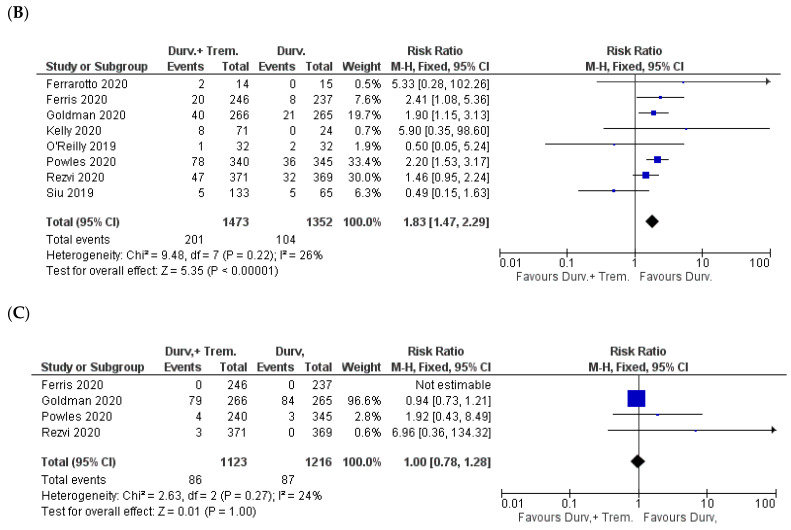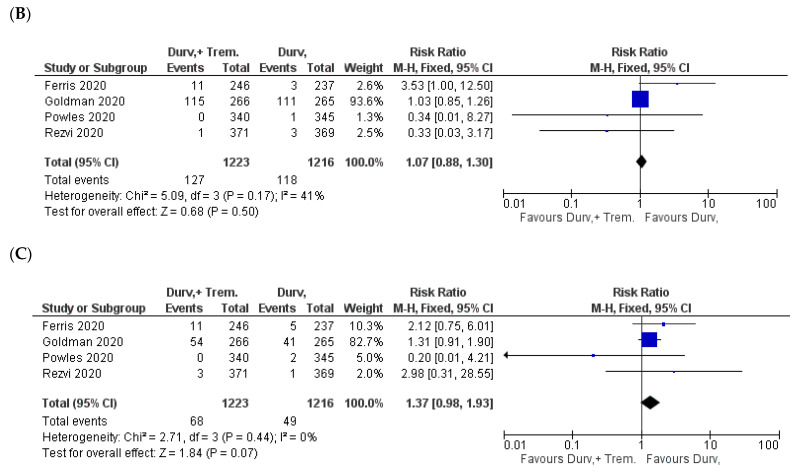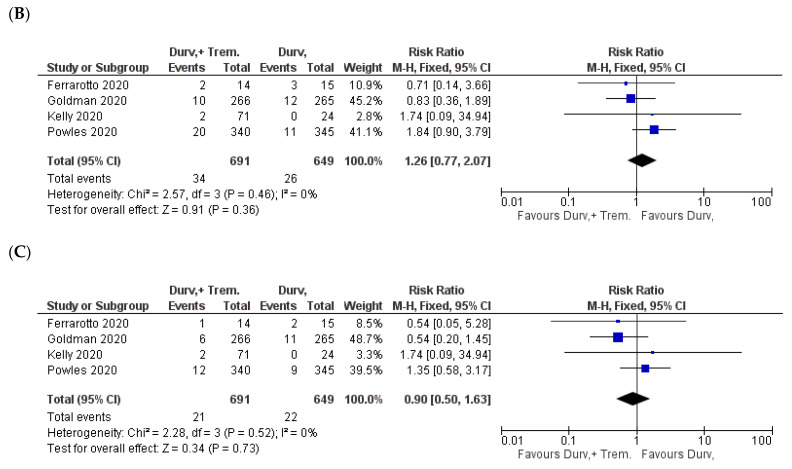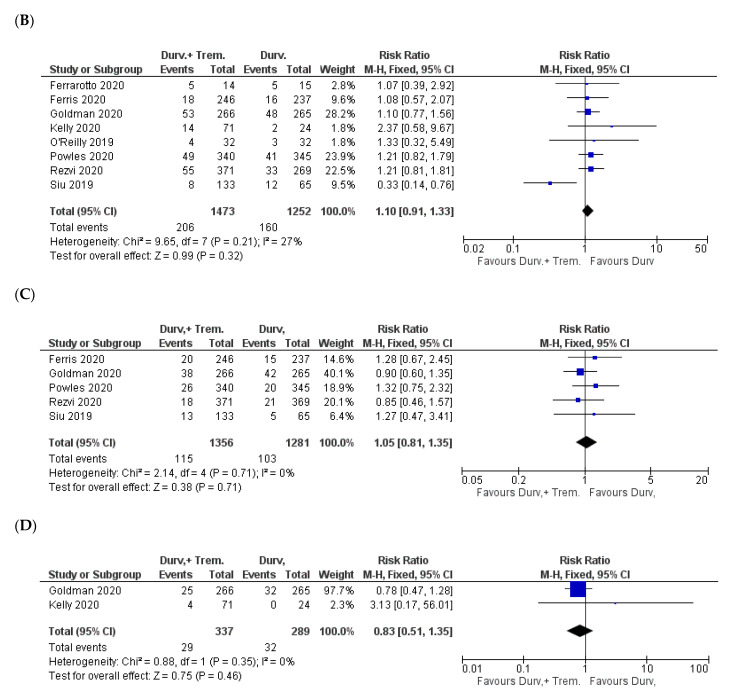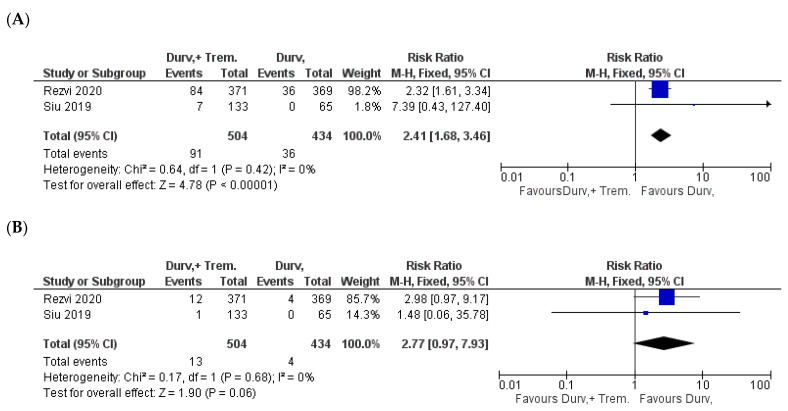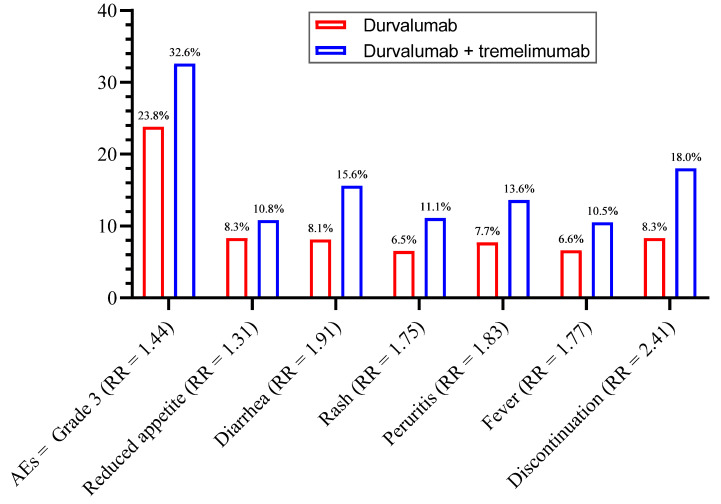Abstract
Background: Recently, the combination of durvalumab and tremelimumab, two immune checkpoint inhibitors, for the treatment of different types of cancers has been considered; however, its overall effects, including its safety, are still unclear and need to be further investigated. Objectives: The aim of the present systematic review and meta-analysis was to investigate the safety and tolerability of this combination of drugs. Methods: A systematic review of the literature, based on the Preferred Reporting Items for Systematic Reviews and Meta-analyses (PRISMA) statement, was conducted by employing online electronic databases and the American Society of Clinical Oncology (ASCO) Meeting Library. The selection of eligible publications was made following a staged screening and selection process. The software RevMan 5.4 was used to run the quantitative analysis and forest plots, while the Cochrane tool was employed for risk of bias assessment. Results: From the retrieved 157 results, 9 randomized controlled trials involving 3060 patients were included. By comparing the combination of durvalumab and tremelimumab vs. durvalumab monotherapy, it was observed that: adverse events (AEs) ≥ Grade 3 incidence was 32.6% (536/1646) vs. 23.8% (336/1414) (Z = 2.80; p = 0.005; risk ratio (RR) = 1.44), reduced appetite incidence was 10.8% (154/1427) vs. 8.3% (108/1305) (Z = 2.26; p = 0.02; RR = 1.31), diarrhea was reported in 15.6% (229/1473) vs. 8.1% (110/1352) (Z = 5.90; p < 0.00001; RR = 1.91), rash incidence was equal to 11.1% (160/1441) vs. 6.5% (86/1320) (Z = 4.35; p <0.0001; RR = 1.75), pruritis was 13.6% (201/1473) vs. 7.7% (104/1352) (Z = 5.35; p < 0.00001; RR = 1.83), fever was 10.5% (42/399) vs. 6.6% (22/330) (Z = 2.27; p = 0.02; RR = 1.77), discontinuation rate was 18% (91/504) vs. 3% (36/434) (Z = 4.78; p < 0.00001; RR = 2.41), and death rate was 2.6% (13/504) vs. 0.7% (3/434) (Z = 1.90; p = 0.06; RR = 2.77). Conclusions: It was observed that the combined (durvalumab and tremelimumab) vs. monotherapy (durvalumab) is associated with a higher risk of treatment discontinuation, mortality, fever, diarrhea, rash, pruritis, and reduced appetite. This information is relevant and should be disclosed, especially to patients that are currently enrolled in clinical trials considering this combined therapy.
Keywords: durvalumab, tremelimumab, combined therapy, monotherapy, checkpoint inhibitors, adverse effects
1. Introduction
A new era in cancer therapy has been started after the introduction of immune checkpoint inhibitors (ICIs), representing the most important development in this field over the past decade [1,2,3]. These innovative drugs have shown promising results, preventing tumor immune escape through immune checkpoints, thus enabling immune cells to maintain their killing effect on malignant cells [4]. Durvalumab is a human immunoglobulin G1 kappa monoclonal antibody and a novel ICI used for cancer treatment [5]. It is a programmed death-ligand 1 (PD-L1) inhibitor able to enhance basal immune responses against tumor cells [6]. Durvalumab was granted accelerated approval by the U.S. Food and Drug Administration (FDA) in 2017 for the treatment of locally advanced or metastatic urothelial carcinoma [7]. One year later (2018), it gained another approval for the treatment of selected patients with locally advanced, unresectable non-small cell lung cancer (NSCLC) [8]. In March 2020, durvalumab was approved to be used as a first line in combination with chemotherapy for patients suffering from extensive stage small cell lung cancer (ES-SCLC) [9]. Tremelimumab is a fully humanized, anti-cytotoxic T-lymphocyte-associated protein 4 (CTLA-4) IgG2 monoclonal antibody [10]. CTLA-4, also known as CD152 (cluster of differentiation 152), is a transmembrane receptor constitutively expressed in regulatory T cells, which promotes immunosuppression in the tumor microenvironment [11]. It is an inhibitory molecule able to regulate T cell expansion and differentiation; in particular, its inhibitory activity has been related to the binding of B7-1/B7-2 ligands [12,13]. In addition to the above, it represents a negative regulator of the immune response and a target for cancer therapy [14]. Blocking of CTLA-4 with tremelimumab allows T cells to proliferate and attack tumor cells. Tremelimumab has been tested on different cancer types, including mesothelioma, bladder cancer, lung cancer, melanoma, liver cancer, and head and neck cancer, but despite some promising results, it has not yet been approved by the FDA to treat any cancer or disease [15].
Although ICIs have been used as immunotherapy to treat many kinds of cancer, leading in some patients to long-lasting remissions, they can cause a range of long-term side effects [11]. In particular, it has been strongly suggested as ICIs possess both direct or indirect reactive oxygen species (ROS)-dependent mechanisms coming from the interactions occurring between programmed cell death-1 (PD-1) antibodies and ROS generation [16], leading to a well-known phenomenon known as oxidative stress [17,18].
The use of ICIs has been associated with a higher incidence of immune-related adverse events (irAEs) compared with chemotherapy [19], often leading to irAEs that are distinctly different from the classical chemotherapy-related toxicities [11]. Common irAEs include dermatologic irAEs (pruritus and rash), endocrine irAEs (hypothyroidism and hyperthyroidism), colitis, pneumonitis, and hepatitis [20]. These irAEs, if not properly treated, might cause treatment termination, failure, or even be life-threatening and fatal [21].
The combination therapy of durvalumab with tremelimumab might boost the anticancer immune activity as each drug possesses a specific pharmacodynamics profile and a defined molecular mechanism of action; indeed, different clinical trials have investigated the combination of these drugs and have shown conflicting results regarding the side effects of adding tremelimumab to durvalumab. For instance, rash, anemia, neutrophilia, fatigue, dyspnea, asthenia, and thyroid dysfunction. All these side effects have been reported to be higher with monotherapy in some studies or higher with combination therapy in other studies [22,23,24,25,26,27]. As safety and tolerability are crucial in medical therapy, especially when employing combination protocols, the aim of this systematic review and meta-analysis was to assess the safety profile as well as the risk of increased side effects due to the combination therapy of durvalumab with tremelimumab compared with durvalumab monotherapy in cancer patients.
2. Materials and Methods
2.1. Search Strategy
We conducted an online systemic search through online electronic databases (PubMed, EMBASE, Wiley Online Library, and Cochrane databases) based on Preferred Reporting Items for Systematic Reviews and Meta-analyses (PRISMA) criteria [28,29]. The following keywords were used during the search: durvalumab, tremelimumab, immunotherapy, and checkpoint inhibitors. The exclusion criteria considered were: (1) review articles, (2) case reports, (3) letters to editors and editorial comments, (4) repeated publications, (5) non-controlled trials, and (6) clinical trial protocols. All the obtained results, initially assessed by the title, with or without abstract assessment, were followed by full-text assessment. The manual search in reference lists of relevant published studies was conducted in order to avoid missing any eligible studies. Eventually, we included the controlled trials with two cohorts, one for durvalumab plus tremelimumab, and one for durvalumab alone. For trials with multiple arms, we included only the two targeted groups (durvalumab plus tremelimumab and durvalumab).
2.2. Data Extraction
Data were independently extracted by two authors and checked by a third one. Discrepancies were resolved after discussion among the three authors. Extracted data: main author and year of publication, timeframe of the study, type of the study and registration number, type of cancer treated, total number of patients in each cohort, doses of durvalumab and tremelimumab, additional treatments, adverse events (AEs), and conclusion of the study. Dichotomous data for analysis were extracted as events and total numbers. The effect measurement was calculated using pooled risk ratio (RR) and 95% confidence interval (CI).
2.3. Primary Outcomes
The primary outcome of this systematic review and meta-analysis was to compare the side effects of the combination of durvalumab and tremelimumab vs. durvalumab monotherapy. The following grading was used for the AEs: Grade (G)1 = mild; G2 = moderate; G3 = severe; G4 = life-threatening; and G5 = death.
2.4. Statistical Analysis
The Nordic Cochrane Centre (Cochrane Collaboration, Copenhagen) employed Review Manager (RevMan) software version 5.4 for statistical analysis and the creation of forest plots for this meta-analysis. In each analysis, the I2 value was used to determine the heterogeneity among the studies. In the cases of I2 < 50% and I2 ≥ 50%, fixed and random effect models were used, respectively. The Z-test was employed to assess the overall impact. Only p-values < 0.05 were considered statistically significant.
2.5. Risk of Bias Assessment
All included studies were randomized, and the Cochrane bias assessment tool of The Nordic Cochrane Centre (Cochrane Collaboration, Copenhagen) Review Manager (RevMan), software version 5.4, was used for the assessment of the risk of bias.
3. Results
3.1. Search Results
An initial search in electronic databases revealed 157 results that underwent initial assessment (through title and abstract). After this stage, 34 publications underwent full-text assessment, 9 of which were randomized controlled trials and were included in the study [22,23,24,25,26,27,30,31,32]. A total number of 3060 patients were included in the pooled analyses: 1646 (53.8%) received durvalumab and tremelimumab, while 1414 (46.2%) received durvalumab monotherapy. The flow of screening, as well as the selection process, are described in Figure 1.
Figure 1.
CONSORT diagram for the screening and selection processes of the included studies.
A summary of the included studies is provided in Table 1.
Table 1.
Summary of the included studies.
| Study | NCT ID/Trial Name | Phase and Status | Timeframe | Patient Criteria | Sample Size (D + T vs. D) | Doses | Outcome |
|---|---|---|---|---|---|---|---|
| Ferrarotto 2020 [22] |
NCT03144778 (CIAO trial) |
Phase I, randomized, open-label, single institution | Jul. 2017–Feb. 2019 | Newly diagnosed stage II-IVA oropharynx cancer or locoregionally recurrent oropharynx cancer amenable to resection | 14 15 |
Two cycles of intravenous D 1500 mg ± T 75 mg on day 1 of a 28-day cycle | D + T did not increase CD8+ TIL density more than D alone |
| Ferris 2020 [23] | NCT02369874 (EAGLE) | Phase III, randomized, open label, multicenter | Nov. 2015–Jul. 2017 | Recurrent or metastatic head and neck squamous cell carcinoma | 246 236 |
D (10 mg/kg every 2 weeks (q2w)), D + T (D 20 mg/kg every 4 weeks (q4w) + T 1 mg/kg q4w up to four doses, followed by D 10 mg/kg q2w) |
Combining D with T did not show improvement over D activity |
| Goldman 2020 [24] | NCT03043872 (CASPIAN) | Phase III, randomized, open label, multicenter | Mar. 2017–May. 2018 | Treatment-naive, histologically or cytologically documented extensive-stage small-cell lung cancer | 266 265 |
Patients in the immunotherapy groups received four cycles of platinum–etoposide + D 1500 mg ± T 75 mg every 3 weeks, followed by maintenance D 1500 mg every 4 weeks. Patients in the D + T + platinum–etoposide group received one additional dose of T 75 mg after platinum–etoposide (up to five doses) | Addition of T to D plus platinum–etoposide did not significantly improve outcomes vs. platinum–etoposide |
| Kelly 2020 [25] | NCT02340975 | Phase 1b/II, randomized, open label, multicenter | Mar. 2015–Jan. 2018 | Metastatic/recurrent gastric or gastroesophageal junction cancer | 71 24 |
D 20 mg/kg + T 1 mg/kg Q4W for four cycles, followed by D 10 mg/kg Q2W. Patients in arm B received D monotherapy (10 mg/kg) Q2W | Response rates were low regardless of monotherapy or combination strategies |
| Planchard 2020 [27] | NCT02352948 (ARCTIC) | Phase III, randomized, open label, multicenter | Jan. 2015–Sep. 2016 | Metastatic NSCLC | 173 62 |
D + T (12 weeks D 20 mg/kg) + T 1 mg/kg q4w then 34 weeks vs. D 10 mg/kg q2w D (up to 12 months 10 mg/kg every 2 weeks (q2w)) |
The efficacy of D + T was comparable with that of D monotherapy, suggesting a limited contribution of T |
| Powles 2020 [30] | NCT02516241 (DANUBE) | Phase III, randomized, open label, multicenter | Nov. 2015–Mar. 2017 | Untreated patients with unresectable, locally advanced, or metastatic urothelial carcinoma | 340 345 |
D monotherapy (at a fixed dose of 1500 mg, administered intravenously every 4 weeks); the combination of D (1500 mg) and T (75 mg), both administered intravenously every 4 weeks for up to four doses, followed by D maintenance monotherapy (1500 mg, administered intravenously every 4 weeks) |
Combination treatment suggests that T has activity in this disease when given in combination with D, but it also increases toxicity |
| Rezvi 2020 [31] |
NCT02453282 (MYSTIC) |
Phase III, randomized, open label, multicenter | Jul. 2015–Jun. 2016 | Metastatic NSCLC | 371 369 |
D (20 mg/kg every 4 weeks) plus T (1 mg/kg every 4 weeks, up to 4 doses), D (20 mg/kg every 4 weeks) |
D + T combination was associated with a higher rate of AEs, leading to discontinuation of D |
| O’Reilly 2019 [26] | NCT02558894 | Phase II, randomized, open label, multicenter | Nov. 2015–Mar. 2017 | Metastatic pancreatic ductal adenocarcinoma | 32 32 |
D therapy (1500 mg every 4 weeks) plus T therapy (75 mg every 4 weeks) for 4 cycles followed by D therapy (1500 mg every 4 weeks) or D monotherapy (1500 mg every 4 weeks) for up to 12 months |
The observed efficacy of D + T therapy and D monotherapy was reflective of a population of patients with mPDAC who had poor prognoses and rapidly progressing disease |
| Siu 2019 [32] |
NCT02319044 (CONDOR) |
Phase II, randomized, open label, multicenter | Apr. 2015–Mar. 2016 | Patients with PD-L1–low/negative recurrent or metastatic head and neck squamous cell carcinoma |
133 65 |
D (20 mg/kg every 4 weeks) + T (1 mg/kg every 4 weeks) for four cycles, followed by D (10 mg/kg every 2 weeks), or D (10 mg/kg every 2 weeks) monotherapy, or T (10 mg/kg every 4 weeks for seven doses then every 12 weeks for two doses) monotherapy | Minimal observed difference between D and D + T |
Risk of bias assessment of the included studies is available in Figure 2 and Figure 3.
Figure 2.
Total percentage risk of bias for all the randomized trials: green, low risk; yellow, unclear; red, high risk.
Figure 3.
Risk of bias in the randomized trials: green, low risk; yellow, unclear; red, high risk.
3.2. Overall Incidence of Side Effects
Considering eight studies with a total of 2865 patients, there was no significant difference in the total number of AEs from any grade. The incidence was 73% (1151/1575) and 70.8% (913/1290) in combination (durvalumab + tremelimumab) vs. monotherapy (durvalumab) patients, respectively (Z = 0.66; p = 0.51; RR = 1.01) [22,23,24,26,27,30,31,32] (Figure 4A).
Figure 4.
Forest plots for the risk ratio of AEs: (A) all AEs; (B) AEs ≥ Grade 3.
In the comparison of AEs ≥ Grade 3, which included all the studies, the incidence was significantly higher in the combination vs. monotherapy patients: 32.6% (536/1646) vs. 23.8% (336/1414) (Z = 2.80; p = 0.005; RR = 1.44) (Figure 4B).
3.3. Gastrointestinal Side Effects
Pooled analysis was feasible for five symptoms (reduced appetite, nausea, vomiting, diarrhea, and constipation). A significantly higher incidence of reduced appetite and diarrhea and a trend toward a higher incidence of vomiting were observed for combination vs. monotherapy patients. For reduced appetite, the incidence was 10.8% (154/1427) in combination vs. 8.3% (108/1305) in monotherapy patients (Z = 2.26; p = 0.02; RR = 1.31) [23,24,25,30,31,32] (Figure 5A).
Figure 5.
Forest plots for the risk ratio of (A) reduced appetite, (B) nausea, (C) vomiting, (D) diarrhea, and (E) constipation.
Nausea was reported to be 10.8% (155/1441) in combination vs. 11% (146/1320) in monotherapy patients (Z = 0.19; p = 0.85; RR = 1.04) [22,23,24,25,30,31,32] (Figure 5B). For vomiting, the incidence was 5.9% (70/1181) in combination vs. 4.8% in monotherapy (51/1068) (Z = 1.49; p = 0.14; RR = 1.30) [24,25,30,31,32] (Figure 5C). Diarrhea was reported in 15.6% (229/1473) in combination vs. 8.1% in monotherapy (110/1352) (Z = 5.90; p < 0.00001; RR = 1.91) [22,23,24,25,26,30,31,32] (Figure 5D). Constipation was reported in 6.9% (67/977) in combination vs. 5.7% (56/979) in monotherapy (Z = 1.07; p = 0.29; RR = 1.19) [24,30,31] (Figure 5E).
3.4. Dermal Manifestations
With regard to dermal manifestations, rash, pruritis, and alopecia were considered and compared. The incidence of both rash and pruritis was significantly higher in combination vs. monotherapy patients. As shown in Figure 6A, rash incidence was 11.1% (160/1441) in combination vs. 6.5% (86/1320) in monotherapy (Z = 4.35; p < 0.0001; RR = 1.75) [22,23,24,25,30,31,32].
Figure 6.
Forest plots for the risk ratio of (A) rash, (B) pruritis, and (C) alopecia.
For pruritis, the incidence was 13.6% (201/1473) in combination vs. 7.7% (104/1352) in monotherapy patients (Z = 5.35; p < 0.00001; RR = 1.83) [22,23,24,25,26,30,31,32] (Figure 6B). Comparable incidence was reported for alopecia, which was 7.7% (86/1123) in combination vs. 7.2% (87/1216) in monotherapy (Z = 0.01; p = 1.00; RR = 1.00) [23,24,30,31] (Figure 6C).
3.5. Hematological Side Effects
When considering hematological side effects, no significant difference in the incidence of anemia, neutropenia, and thrombocytopenia was observed. However, there was a trend toward a higher incidence of thrombocytopenia for combination vs. monotherapy patients. Anemia was recorded in 10.5% (144/1370) in combination vs. 10.3% (133/1296) in monotherapy (Z = 0.52; p = 0.60; RR = 1.05) [22,23,24,30,31,32] (Figure 7A).
Figure 7.
Forest plots for the risk ratio of (A) anemia, (B) neutropenia, and (C) thrombocytopenia.
Similarly, neutropenia was reported in 10.4% (127/1223) in combination vs. 9.7% (118/1216) in monotherapy patients (Z = 0.68; p = 0.50; RR = 1.07) [23,24,30,31] (Figure 7B). Lastly, thrombocytopenia was reported in 5.6% (68/1223) in combination vs. 4% (49/1216) in monotherapy (Z = 1.84; p = 0.07; RR = 1.37) [23,24,30,31] (Figure 7C).
3.6. Metabolic and Endocrine Manifestations
With respect to metabolic and endocrine manifestations, a comparable incidence of hypothyroidism as well as an elevation of both lipase and amylase enzymes were observed. Hypothyroidism was reported in 10.3% (51/496) in combination vs. 9.9% (37/373) in monotherapy patients (Z = 0.58; p = 0.56; RR = 1.12) [22,23,25,26,32] (Figure 8A).
Figure 8.
Forest plots for the risk ratio of (A) hypothyroidism, (B) increased lipase, and (C) increased amylase.
Increased lipase incidence was 4.9% (34/691) in combination vs. 4% (26/649) in monotherapy patients (Z = 0.91; p = 0.36; RR = 1.26) [22,24,25,30]. However, increased amylase incidence was 3% (21/691) in combination vs. 3.4% (22/649) in monotherapy (Z = 0.34; p = 0.73; RR = 0.90) [22,24,25,30] (Figure 8B,C).
3.7. General Manifestations
Among fever, fatigue, asthenia, and dyspnea, only fever showed significant higher incidence in combination vs. monotherapy patients. Fever was 10.5% (42/399) in combination vs. 6.6% (22/330) in monotherapy (Z = 2.27; p = 0.02; RR = 1.77) [24,32] (Figure 9A).
Figure 9.
Forest plots for the risk ratio of (A) fever, (B) fatigue, (C) asthenia, and (D) dyspnea.
Fatigue was reported in 14% (206/1473) in combination vs. 12.8% (160/1252) in monotherapy patients (Z = 0.99; p = 0.32; RR = 1.10) [22,23,24,25,26,30,31,32] (Figure 9B). In the case of asthenia, the incidence was 8.5% (115/1356) in combination vs. 8% (103/1281) in monotherapy (Z = 0.38; p = 0.71; RR = 1.05) [23,24,30,31,32] (Figure 9C). Dyspnea was insignificantly lower in combination therapy, 8.6% (29/337) vs. 11% (32/289) in monotherapy (Z = 0.75; p = 0.46; RR = 0.83) [24,25] (Figure 9D).
3.8. Treatment Discontinuation and Mortality
Discontinuation rate was markedly higher in combination compared with monotherapy patients; in fact, it was 18% (91/504) in combination vs. 8.3% (36/434) in monotherapy (Z = 4.78; p < 0.00001; RR = 2.41) [31,32] (Figure 10A).
Figure 10.
Forest plots for the risk ratio of (A) discontinuation and (B) death.
Mortality for combination vs. monotherapy was also higher, even though with marginal p-value, just below the significance level. In particular, death rate was 2.6% (13/504) for combination compared with 0.7% (3/434) for monotherapy patients (Z = 1.90; p = 0.06; RR = 2.77) [31,32] (Figure 10B).
All significant results of this meta-analysis are summarized in Figure 11.
Figure 11.
Summary of the significant results (p < 0.05).
4. Discussion
ICIs are part of the standard of care for patients with many advanced solid tumors, displaying a durable response up to complete regression of metastatic lesions in different cancer types such as NSCLC [33]. One of the challenging points regarding the use of ICIs is represented by the identification of real predictive biomarkers that can help in the selection of patients before starting treatment. In fact, the identification of biomarkers is usually obtained by analyzing tissue biopsies that might not be available for every patient. Especially in the case of patients presenting severe and/or steroid-refractory irAEs, a biopsy sample should be obtained and analyzed for infiltrating immune cells, allowing the selection of novel biological agents targeting crucial inflammatory mediators [11,34]. The difficulty in obtaining biopsies, along with a long time of preservation and technical processing, could lead to the alteration of the molecular properties of the tissue samples [34,35].
ICIs such as durvalumab, tremelimumab, and ipilimumab have been investigated as monotherapy, as well as in different combination approaches, such as with chemotherapy or other ICI agents [36,37,38]. The rationale behind the use of durvalumab and tremelimumab combination is to enhance antitumor immune activity through two different mechanisms related to the inhibition of PD-L1/programmed cell death-1 (PD-1) and CTLA-4 pathways: anti-PD-L1/anti-PD-1 operates in the tumor microenvironment and prevents T cell function inhibition, whilst anti-CTLA-4 acts in the lymphoid compartment to increase the number of tumor-reactive T cells [39,40]. The combination of CTLA-4 and PD-1 blockade has been shown to be able to improve antitumor responses; in this regard, it has been shown that the monoclonal anti-CTLA4 antibody ipilimumab is able to increase tumor-infiltrating T cells and up-regulate the PD-1/PD-L1 inhibitory pathway in a compensatory manner, highlighting how drug combination therapy applications may be very effective [41].
Combined PD-L1 and CTLA-4 inhibition has shown synergistic effects in preclinical models [42], and it has been approved as a first-line therapy for metastatic NSCLC [31], but an open question remains concerning the additional clinical benefit of this combination compared with chemotherapy plus PD-L1 inhibition [43]. Recent studies suggest that patients with metastatic melanoma who progress on PD-L1-directed therapy can respond to combined PD-L1 and CTLA-4 inhibition [44], but it is still not clear the clinical impact of this combination in terms of safety. A very recent study from Schoenfeld et al. [45] found that combined PD-L1 and CTLA-4 inhibition in NSCLC resistant to PD-L1 inhibition was relatively well tolerated, with an overall prevalence of grade 3 or higher treatment-related AEs compared with the 22% prevalence detected with durvalumab–tremelimumab in the ARCTIC trial [27].
In the present systematic review and meta-analysis, we managed to provide a detailed evaluation of the additional risk in terms of safety when combining tremelimumab with durvalumab. It is well-known that the administration of multiple medications could increase the chances of side effects or drug–drug interactions in patients, even though the negative outcome can be tolerable without significant impact on patient life [46]. In the case of the combination of durvalumab and tremelimumab, the current literature does not provide a clear answer on how significant is the risk of combining these two drugs. Addressing this question is very useful to help during counseling of patients before enrollment in such studies as well as to plan future clinical trials. All trials included in this analysis were randomized and controlled, strengthening the level of evidence of our results (libguides.winona.edu/ebptoolkit/Levels-Evidence (accessed on 14 November 2021)). It is worth mentioning that non-randomized controlled trials have not been excluded a priori; however, our research, by using electronic databases, did not lead to the identification of any of them. Since the aim of our study was to investigate the side effects and tolerability, the oncological response was not included in the analysis, as patients had different types of cancers. Therefore, we could not perform a pooled analysis to investigate the efficacy.
Assessment of additional risk should be evaluated by looking at both RR (the probability of having the event) and the absolute risk (the real reported difference in the incidence between the two cohorts) (www.ncbi.nlm.nih.gov/books/NBK63647, (accessed on 27 February 2022)). The highest RR in our study was observed for mortality (RR = 2.77), which means that adding tremelimumab to durvalumab will increase the risk of mortality almost three times when compared with durvalumab administrated alone; however, the p-value did not reach the significance level probably due to the low number of studies. A very low incidence of mortality in both arms (2.6% vs. 0.7%) was observed, meaning that the absolute risk of mortality is less than 2%. The second highest risk was identified to be discontinuity, which was about 2.5 folds higher for combination vs. monotherapy. The remaining significant RRs in our analysis were always below 2, meaning that the additional risk coming from the use of tremelimumab with durvalumab to produce those side effects is below two-fold.
As mentioned earlier, more side effects are expected to be reported with combination therapy compared with monotherapy. However, in view of the overwhelming number of reported side effects for ICIs, it is clinically very useful to specify which AEs are more expected when administering a combination therapy. Among the different AEs reported in the included studies, our analysis was able to identify certain AEs, such as fever, diarrhea, rash, pruritis, and reduced appetite, to be higher with combination therapy compared with durvalumab monotherapy. Additionally, a higher risk of treatment discontinuation and mortality was observed.
The results of our analysis point out the fact that especially high-risk patients receiving an ICIs-based therapy should be regularly and frequently monitored for treatment-related complications and, in the best scenario, be subjected to a personalized surveillance strategy [11]. The latter is of utmost importance in light of the fact that the frequency and variability of irAEs could be affected by different variables such as the agents used, the exposure time and the administered dose, and the patient’s intrinsic risk factors.
Despite the high level of evidence presented in this study, there are some limitations that should be considered, for instance, the limited number of included studies. Additionally, some trials are phase I or II. Patients taken into account in the present study had different types of cancers and patient intrinsic risk factors, with or without previous treatments, which may affect the outcome. Lastly, in some studies, patients received chemotherapy along with immunotherapy. The variation in immunotherapy protocols, drug doses, the duration of therapy, and follow-up might have impacted the tolerability. All these factors will limit the clinical impact of this study. Recent studies suggest that durvalumab–tremelimumab combination can provide meaningful clinical benefit in specific tumors such as the subgroup of patients with NSCLC who progressed on PD-1-directed therapy [45], but it will be essential in future studies to assess whether biomarkers of tumor-infiltrating CD8+ and CD4+ T cells at baseline are associated with an increased response to combined PD-L1 and CTLA-4 inhibition and better tolerability of this combination.
5. Conclusions
Our results highlight how the combination of durvalumab with tremelimumab increases the risk of treatment discontinuation and mortality compared with durvalumab monotherapy. Additionally, a higher risk of developing fever, diarrhea, rash, and pruritis, along with reduced appetite, was observed. This must be highlighted to patients during counseling before enrollment in clinical trials in which a combined therapy consisting of durvalumab and tremelimumab will be used. Based on the present study, further investigations, especially regarding safety, are required to justify the use of this drug combination.
Acknowledgments
The authors acknowledge with thanks to DSR for technical and financial support.
Author Contributions
Conceptualization, O.F. and G.C.; methodology, O.F. and M.G.K.-A.; software, O.F. and W.S.A.; validation, O.F., G.C. and F.C.; formal analysis, M.A.E.-M.; investigation, C.G.F.; resources, O.A.A.A.; data curation, U.A.F.; writing—original draft preparation, O.F. and G.C.; writing—review and editing, C.G.F., G.C., O.A.A.A. and M.G.K.-A.; visualization, W.S.A.; supervision, N.A.A.; project administration, N.A.A.; funding acquisition, U.A.F. All authors have read and agreed to the published version of the manuscript.
Institutional Review Board Statement
Not applicable.
Informed Consent Statement
Not applicable.
Data Availability Statement
Not applicable.
Conflicts of Interest
The authors declare no conflict of interest.
Funding Statement
This research was funded by the Deanship of Scientific Research (DSR) at King Abdulaziz University, Jeddah, Saudi Arabia, for funding this project under grant number (FP-028-43).
Footnotes
Publisher’s Note: MDPI stays neutral with regard to jurisdictional claims in published maps and institutional affiliations.
References
- 1.Fahmy O., Khairul-Asri M.G., Stenzl A., Gakis G. The current status of checkpoint inhibitors in metastatic bladder cancer. Clin. Exp. Metastasis. 2016;33:629–635. doi: 10.1007/s10585-016-9807-9. [DOI] [PubMed] [Google Scholar]
- 2.Fahmy O., Alhakamy N.A., Khairul-Asri M.G., Ahmed O.A.A., Fahmy U.A., Fresta C.G., Caruso G. Oncological response and predictive biomarkers for the checkpoint inhibitors in castration-resistant metastatic prostate cancer: A systematic review and meta-analysis. J. Pers. Med. 2021;12:8. doi: 10.3390/jpm12010008. [DOI] [PMC free article] [PubMed] [Google Scholar]
- 3.Fahmy O., Alhakamy N.A., Rizg W.Y., Bagalagel A., Alamoudi A.J., Aldawsari H.M., Khateb A.M., Eldakhakhny B.M., Fahmy U.A., Abdulaal W.H., et al. Updates on molecular and biochemical development and progression of prostate cancer. J. Clin. Med. 2021;10:5127. doi: 10.3390/jcm10215127. [DOI] [PMC free article] [PubMed] [Google Scholar]
- 4.Shsm H., Fahmy U.A., Alhakamy N.A., Khairul-Asri M.G., Fahmy O. Neoadjuvant therapy using checkpoint inhibitors before radical cystectomy for muscle invasive bladder cancer: A systematic review. J. Pers. Med. 2021;11:1195. doi: 10.3390/jpm11111195. [DOI] [PMC free article] [PubMed] [Google Scholar]
- 5.Wills S., Hochmuth L.K., Bauer K.S., Jr., Deshmukh R. Durvalumab: A newly approved checkpoint inhibitor for the treatment of urothelial carcinoma. Curr. Probl. Cancer. 2019;43:181–194. doi: 10.1016/j.currproblcancer.2018.08.010. [DOI] [PubMed] [Google Scholar]
- 6.Syn N.L., Teng M.W.L., Mok T.S.K., Soo R.A. De-novo and acquired resistance to immune checkpoint targeting. Lancet Oncol. 2017;18:e731–e741. doi: 10.1016/S1470-2045(17)30607-1. [DOI] [PubMed] [Google Scholar]
- 7.Lopez-Beltran A., Cimadamore A., Blanca A., Massari F., Vau N., Scarpelli M., Cheng L., Montironi R. Immune checkpoint inhibitors for the treatment of bladder cancer. Cancers. 2021;13:131. doi: 10.3390/cancers13010131. [DOI] [PMC free article] [PubMed] [Google Scholar]
- 8.Fitzpatrick O., Naidoo J. Immunotherapy for stage iii nsclc: Durvalumab and beyond. Lung Cancer. 2021;12:123–131. doi: 10.2147/LCTT.S305466. [DOI] [PMC free article] [PubMed] [Google Scholar]
- 9.Al-Salama Z.T. Durvalumab: A review in extensive-stage sclc. Target Oncol. 2021;16:857–864. doi: 10.1007/s11523-021-00843-0. [DOI] [PMC free article] [PubMed] [Google Scholar]
- 10.Ribas A. Clinical development of the anti-ctla-4 antibody tremelimumab. Semin Oncol. 2010;37:450–454. doi: 10.1053/j.seminoncol.2010.09.010. [DOI] [PubMed] [Google Scholar]
- 11.Martins F., Sofiya L., Sykiotis G.P., Lamine F., Maillard M., Fraga M., Shabafrouz K., Ribi C., Cairoli A., Guex-Crosier Y., et al. Adverse effects of immune-checkpoint inhibitors: Epidemiology, management and surveillance. Nat. Rev. Clin. Oncol. 2019;16:563–580. doi: 10.1038/s41571-019-0218-0. [DOI] [PubMed] [Google Scholar]
- 12.Chikuma S., Abbas A.K., Bluestone J.A. B7-independent inhibition of t cells by ctla-4. J. Immunol. 2005;175:177–181. doi: 10.4049/jimmunol.175.1.177. [DOI] [PubMed] [Google Scholar]
- 13.Brzostek J., Gascoigne N.R., Rybakin V. Cell type-specific regulation of immunological synapse dynamics by b7 ligand recognition. Front Immunol. 2016;7:24. doi: 10.3389/fimmu.2016.00024. [DOI] [PMC free article] [PubMed] [Google Scholar]
- 14.Keilholz U. Ctla-4: Negative regulator of the immune response and a target for cancer therapy. J. Immunother. 2008;31:431–439. doi: 10.1097/CJI.0b013e318174a4fe. [DOI] [PubMed] [Google Scholar]
- 15.Ribas A. Tumor immunotherapy directed at pd-1. N Engl J Med. 2012;366:2517–2519. doi: 10.1056/NEJMe1205943. [DOI] [PubMed] [Google Scholar]
- 16.Sabbatino F., Conti V., Liguori L., Polcaro G., Corbi G., Manzo V., Tortora V., Carlomagno C., Vecchione C., Filippelli A., et al. Molecules and mechanisms to overcome oxidative stress inducing cardiovascular disease in cancer patients. Life. 2021;11:105. doi: 10.3390/life11020105. [DOI] [PMC free article] [PubMed] [Google Scholar]
- 17.Teppo H.R., Soini Y., Karihtala P. Reactive oxygen species-mediated mechanisms of action of targeted cancer therapy. Oxid. Med. Cell Longev. 2017;2017:1485283. doi: 10.1155/2017/1485283. [DOI] [PMC free article] [PubMed] [Google Scholar]
- 18.Caruso G., Fresta C.G., Grasso M., Santangelo R., Lazzarino G., Lunte S.M., Caraci F. Inflammation as the common biological link between depression and cardiovascular diseases: Can carnosine exert a protective role? Curr. Med. Chem. 2020;27:1782–1800. doi: 10.2174/0929867326666190712091515. [DOI] [PubMed] [Google Scholar]
- 19.Remon J., Passiglia F., Ahn M.J., Barlesi F., Forde P.M., Garon E.B., Gettinger S., Goldberg S.B., Herbst R.S., Horn L., et al. Immune checkpoint inhibitors in thoracic malignancies: Review of the existing evidence by an iaslc expert panel and recommendations. J. Thorac. Oncol. 2020;15:914–947. doi: 10.1016/j.jtho.2020.03.006. [DOI] [PubMed] [Google Scholar]
- 20.Baxi S., Yang A., Gennarelli R.L., Khan N., Wang Z., Boyce L., Korenstein D. Immune-related adverse events for anti-pd-1 and anti-pd-l1 drugs: Systematic review and meta-analysis. BMJ. 2018;360:k793. doi: 10.1136/bmj.k793. [DOI] [PMC free article] [PubMed] [Google Scholar]
- 21.Thakker R.A., Lee M.A., Albaeni A., Elbadawi A., Suthar K.H., Perez C., Sonstein L.K., Farr N.M., Venkatesan R., Khalife W., et al. Clinical characteristics and outcomes in immune checkpoint inhibitor therapy-associated myocarditis. Cardiol. Res. 2021;12:270–278. doi: 10.14740/cr1319. [DOI] [PMC free article] [PubMed] [Google Scholar]
- 22.Ferrarotto R., Bell D., Rubin M.L., Hutcheson K.A., Johnson J.M., Goepfert R.P., Phan J., Elamin Y.Y., Torman D.K., Warneke C.L., et al. Impact of neoadjuvant durvalumab with or without tremelimumab on cd8(+) tumor lymphocyte density, safety, and efficacy in patients with oropharynx cancer: Ciao trial results. Clin. Cancer Res. 2020;26:3211–3219. doi: 10.1158/1078-0432.CCR-19-3977. [DOI] [PMC free article] [PubMed] [Google Scholar]
- 23.Ferris R.L., Haddad R., Even C., Tahara M., Dvorkin M., Ciuleanu T.E., Clement P.M., Mesia R., Kutukova S., Zholudeva L., et al. Durvalumab with or without tremelimumab in patients with recurrent or metastatic head and neck squamous cell carcinoma: Eagle, a randomized, open-label phase iii study. Ann. Oncol. 2020;31:942–950. doi: 10.1016/j.annonc.2020.04.001. [DOI] [PubMed] [Google Scholar]
- 24.Goldman J.W., Dvorkin M., Chen Y., Reinmuth N., Hotta K., Trukhin D., Statsenko G., Hochmair M.J., Özgüroğlu M., Ji J.H., et al. Durvalumab, with or without tremelimumab, plus platinum-etoposide versus platinum-etoposide alone in first-line treatment of extensive-stage small-cell lung cancer (caspian): Updated results from a randomised, controlled, open-label, phase 3 trial. Lancet Oncol. 2021;22:51–65. doi: 10.1016/S1470-2045(20)30539-8. [DOI] [PubMed] [Google Scholar]
- 25.Kelly R.J., Lee J., Bang Y.J., Almhanna K., Blum-Murphy M., Catenacci D.V.T., Chung H.C., Wainberg Z.A., Gibson M.K., Lee K.W., et al. Safety and efficacy of durvalumab and tremelimumab alone or in combination in patients with advanced gastric and gastroesophageal junction adenocarcinoma. Clin. Cancer Res. 2020;26:846–854. doi: 10.1158/1078-0432.CCR-19-2443. [DOI] [PMC free article] [PubMed] [Google Scholar]
- 26.O’Reilly E.M., Oh D.Y., Dhani N., Renouf D.J., Lee M.A., Sun W., Fisher G., Hezel A., Chang S.C., Vlahovic G., et al. Durvalumab with or without tremelimumab for patients with metastatic pancreatic ductal adenocarcinoma: A phase 2 randomized clinical trial. JAMA Oncol. 2019;5:1431–1438. doi: 10.1001/jamaoncol.2019.1588. [DOI] [PMC free article] [PubMed] [Google Scholar]
- 27.Planchard D., Reinmuth N., Orlov S., Fischer J.R., Sugawara S., Mandziuk S., Marquez-Medina D., Novello S., Takeda Y., Soo R., et al. Arctic: Durvalumab with or without tremelimumab as third-line or later treatment of metastatic non-small-cell lung cancer. Ann. Oncol. 2020;31:609–618. doi: 10.1016/j.annonc.2020.02.006. [DOI] [PubMed] [Google Scholar]
- 28.Moher D., Shamseer L., Clarke M., Ghersi D., Liberati A., Petticrew M., Shekelle P., Stewart L.A. Preferred reporting items for systematic review and meta-analysis protocols (prisma-p) 2015 statement. Syst. Rev. 2015;4:1. doi: 10.1186/2046-4053-4-1. [DOI] [PMC free article] [PubMed] [Google Scholar]
- 29.Caruso G., Godos J., Castellano S., Micek A., Murabito P., Galvano F., Ferri R., Grosso G., Caraci F. The therapeutic potential of carnosine/anserine supplementation against cognitive decline: A systematic review with meta-analysis. Biomedicines. 2021;9:253. doi: 10.3390/biomedicines9030253. [DOI] [PMC free article] [PubMed] [Google Scholar]
- 30.Powles T., van der Heijden M.S., Castellano D., Galsky M.D., Loriot Y., Petrylak D.P., Ogawa O., Park S.H., Lee J.L., De Giorgi U., et al. Durvalumab alone and durvalumab plus tremelimumab versus chemotherapy in previously untreated patients with unresectable, locally advanced or metastatic urothelial carcinoma (danube): A randomised, open-label, multicentre, phase 3 trial. Lancet Oncol. 2020;21:1574–1588. doi: 10.1016/S1470-2045(20)30541-6. [DOI] [PubMed] [Google Scholar]
- 31.Rizvi N.A., Cho B.C., Reinmuth N., Lee K.H., Luft A., Ahn M.J., van den Heuvel M.M., Cobo M., Vicente D., Smolin A., et al. Durvalumab with or without tremelimumab vs standard chemotherapy in first-line treatment of metastatic non-small cell lung cancer: The mystic phase 3 randomized clinical trial. JAMA Oncol. 2020;6:661–674. doi: 10.1001/jamaoncol.2020.0237. [DOI] [PMC free article] [PubMed] [Google Scholar]
- 32.Siu L.L., Even C., Mesía R., Remenar E., Daste A., Delord J.P., Krauss J., Saba N.F., Nabell L., Ready N.E., et al. Safety and efficacy of durvalumab with or without tremelimumab in patients with pd-l1-low/negative recurrent or metastatic hnscc: The phase 2 condor randomized clinical trial. JAMA Oncol. 2019;5:195–203. doi: 10.1001/jamaoncol.2018.4628. [DOI] [PMC free article] [PubMed] [Google Scholar]
- 33.Parikh R.B., Min E.J., Wileyto E.P., Riaz F., Gross C.P., Cohen R.B., Hubbard R.A., Long Q., Mamtani R. Uptake and survival outcomes following immune checkpoint inhibitor therapy among trial-ineligible patients with advanced solid cancers. JAMA Oncol. 2021;7:1843. doi: 10.1001/jamaoncol.2021.4971. [DOI] [PMC free article] [PubMed] [Google Scholar]
- 34.Russo G.I., Musso N., Romano A., Caruso G., Petralia S., Lanzanò L., Broggi G., Camarda M. The role of dielectrophoresis for cancer diagnosis and prognosis. Cancers. 2021;14:198. doi: 10.3390/cancers14010198. [DOI] [PMC free article] [PubMed] [Google Scholar]
- 35.Patel S.P., Kurzrock R. Pd-l1 expression as a predictive biomarker in cancer immunotherapy. Mol. Cancer Ther. 2015;14:847–856. doi: 10.1158/1535-7163.MCT-14-0983. [DOI] [PubMed] [Google Scholar]
- 36.Hotte S., Winquist E., Chi K., Ellard S., Sridhar S., Emmenegger U., Salim M., Iqbal N., Canil C., Kollmannsberger C. Cctg ind 232: A phase ii study of durvalumab with or without tremelimumab in patients with metastatic castration resistant prostate cancer (mcrpc) Ann. Oncol. 2019;30:v885. doi: 10.1093/annonc/mdz394.044. [DOI] [Google Scholar]
- 37.Kwon E.D., Drake C.G., Scher H.I., Fizazi K., Bossi A., Van den Eertwegh A.J., Krainer M., Houede N., Santos R., Mahammedi H. Ipilimumab versus placebo after radiotherapy in patients with metastatic castration-resistant prostate cancer that had progressed after docetaxel chemotherapy (ca184-043): A multicentre, randomised, double-blind, phase 3 trial. Lancet Oncol. 2014;15:700–712. doi: 10.1016/S1470-2045(14)70189-5. [DOI] [PMC free article] [PubMed] [Google Scholar]
- 38.Karzai F., VanderWeele D., Madan R.A., Owens H., Cordes L.M., Hankin A., Couvillon A., Nichols E., Bilusic M., Beshiri M.L., et al. Activity of durvalumab plus olaparib in metastatic castration-resistant prostate cancer in men with and without DNA damage repair mutations. J. Immunother. Cancer. 2018;6:141. doi: 10.1186/s40425-018-0463-2. [DOI] [PMC free article] [PubMed] [Google Scholar]
- 39.Calabrò L., Morra A., Giannarelli D., Amato G., D’Incecco A., Covre A., Lewis A., Rebelatto M.C., Danielli R., Altomonte M., et al. Tremelimumab combined with durvalumab in patients with mesothelioma (nibit-meso-1): An open-label, non-randomised, phase 2 study. Lancet Respir. Med. 2018;6:451–460. doi: 10.1016/S2213-2600(18)30151-6. [DOI] [PubMed] [Google Scholar]
- 40.Calabrò L., Morra A., Fonsatti E., Cutaia O., Amato G., Giannarelli D., Di Giacomo A.M., Danielli R., Altomonte M., Mutti L., et al. Tremelimumab for patients with chemotherapy-resistant advanced malignant mesothelioma: An open-label, single-arm, phase 2 trial. Lancet Oncol. 2013;14:1104–1111. doi: 10.1016/S1470-2045(13)70381-4. [DOI] [PubMed] [Google Scholar]
- 41.Intlekofer A.M., Thompson C.B. At the bench: Preclinical rationale for ctla-4 and pd-1 blockade as cancer immunotherapy. J. Leukoc. Biol. 2013;94:25–39. doi: 10.1189/jlb.1212621. [DOI] [PMC free article] [PubMed] [Google Scholar]
- 42.Wei S.C., Levine J.H., Cogdill A.P., Zhao Y., Anang N.A.S., Andrews M.C., Sharma P., Wang J., Wargo J.A., Pe’er D., et al. Distinct cellular mechanisms underlie anti-ctla-4 and anti-pd-1 checkpoint blockade. Cell. 2017;170:1120–1133.e1117. doi: 10.1016/j.cell.2017.07.024. [DOI] [PMC free article] [PubMed] [Google Scholar]
- 43.Leighl N.B., Redman M.W., Rizvi N., Hirsch F.R., Mack P.C., Schwartz L.H., Wade J.L., Irvin W.J., Reddy S.C., Crawford J., et al. Phase ii study of durvalumab plus tremelimumab as therapy for patients with previously treated anti-pd-1/pd-l1 resistant stage iv squamous cell lung cancer (lung-map substudy s1400f, nct03373760) J. Immunother. Cancer. 2021;9:e002973. doi: 10.1136/jitc-2021-002973. [DOI] [PMC free article] [PubMed] [Google Scholar]
- 44.Pires da Silva I., Ahmed T., Reijers I.L.M., Weppler A.M., Betof Warner A., Patrinely J.R., Serra-Bellver P., Allayous C., Mangana J., Nguyen K., et al. Ipilimumab alone or ipilimumab plus anti-pd-1 therapy in patients with metastatic melanoma resistant to anti-pd-(l)1 monotherapy: A multicentre, retrospective, cohort study. Lancet Oncol. 2021;22:836–847. doi: 10.1016/S1470-2045(21)00097-8. [DOI] [PubMed] [Google Scholar]
- 45.Schoenfeld J.D., Giobbie-Hurder A., Ranasinghe S., Kao K.Z., Lako A., Tsuji J., Liu Y., Brennick R.C., Gentzler R.D., Lee C., et al. Durvalumab plus tremelimumab alone or in combination with low-dose or hypofractionated radiotherapy in metastatic non-small-cell lung cancer refractory to previous pd(l)-1 therapy: An open-label, multicentre, randomised, phase 2 trial. Lancet Oncol. 2022;23:279–291. doi: 10.1016/S1470-2045(21)00658-6. [DOI] [PMC free article] [PubMed] [Google Scholar]
- 46.Smolarz B., Makowska M., Romanowicz H. Pharmacogenetics of drug-resistant epilepsy (review of literature) Int. J. Mol. Sci. 2021;22:11696. doi: 10.3390/ijms222111696. [DOI] [PMC free article] [PubMed] [Google Scholar]
Associated Data
This section collects any data citations, data availability statements, or supplementary materials included in this article.
Data Availability Statement
Not applicable.



